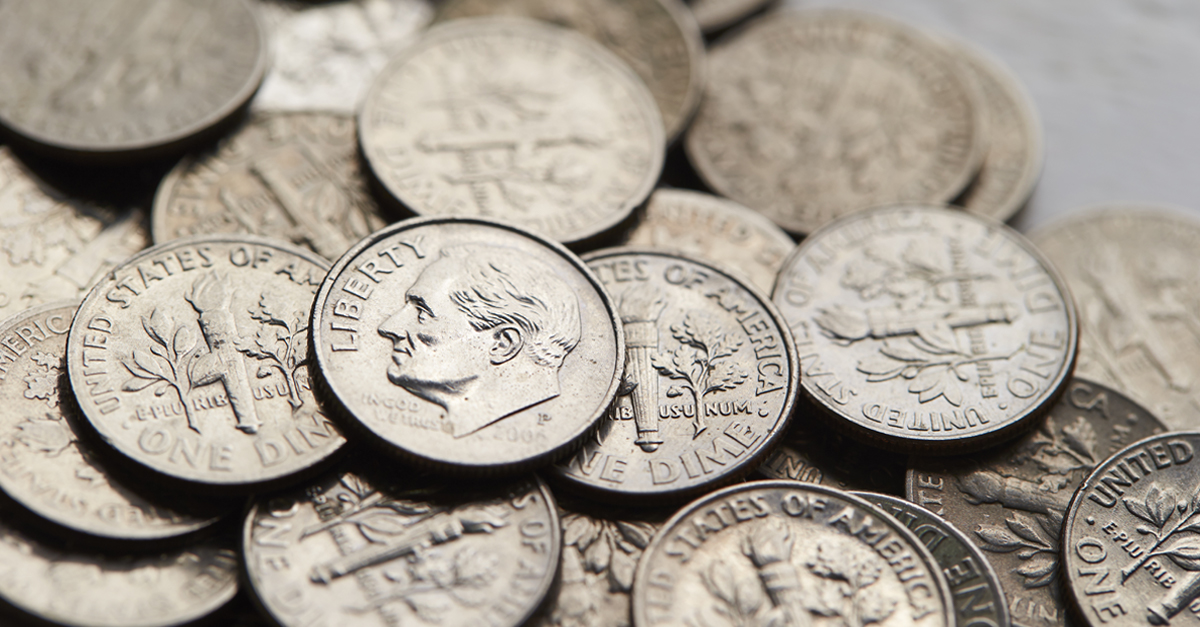A familiar-looking Roosevelt dime could be worth up to $30,000. But it has to be dated 1965, and it has to be made from silver. You could discover such a dime in your attic, coin jar, an old collecting book or even just in pocket change.
Here’s why one thin dime can be worth so much: Way back when, the U.S. Mint was getting ready to discontinue producing silver Roosevelt dimes dated “1964.” In place of silver, dimes dated “1965” (and later) were to be made from a metallic clad sandwich called “cupronickel” (copper and nickel).
But an accident happened. Apparently, the Mint was making both the 1964 silver dimes and the 1965 clad dimes at the same time, and someone at the Mint mistakenly substituted a silver disk (collectors call this a “planchet”) for a clad disk when a run of 1965 dimes was being made. Estimates are that several hundred 1965 silver Roosevelt dimes are out there waiting to be discovered.

Before you get too excited, understand that the 1965 silver dimes are extremely difficult to come by not only because only a few hundred were probably made, but also because so many run-of-the-mill 1965 non-silver dimes were made—more than 1.6 billion of them. But more of the valuable 1965 silver dimes are almost certainly out there in the wild, and occasionally someone notices one, realizes what he has, and is able to cash in this “pocket change lottery” find for thousands of dollars.
If you want to enter this lottery, it doesn’t cost you anything but a little time—time spent checking out the dimes you come across. It’s not hard to do. When you spot any 1965 dime, carefully inspect its ridged edge (this is technically called a “reeded” edge) to see whether there’s a visible strip of copper-brown running around it. If so, you’ve got a correctly-made clad dime that’s worth…10 cents.
The 1965 silver dimes are made from 90% silver. So if you examine the edge of a 1965 silver dime, or any other silver dime for that matter, the edge will appear silver with no copper-colored strip.
Weighing 1965 Roosevelt dimes can prove helpful. The silver dime, before circulating, weighs 2.50 grams (0.084 ounce). The clad dime, before circulating, weighs 2.27 grams (0.080 ounce). (Once a coin circulates, especially if it becomes well worn, it loses metal and weighs a bit less.)
If you are lucky enough to find a 1965 silver dime, its value will depend on its condition. The lightly circulated example shown here was sold at public auction after a viewer of WNBC-TV in New York watched one of my appearances with another 1965 silver Roosevelt dime that I recently sold to a collector and contacted me about his coin.

I advised him, as I would advise you, to get the coin’s genuineness certified by a coin grading service, such as the Professional Coin Grading Service (PCGS), which certified this coin, or the Numismatic Guaranty Corporation (NGC), which certified other examples. These organizations use non-destructive authentication techniques to verify the authenticity of coins and then grade them on a scale of one through 70, where one is the roughest grade and 70 is perfect. The closer to 70 that a 1965 silver dime is graded, the more valuable it is.
The story of that WNBC-TV viewer had a happy ending, as PCGS confirmed that his coin was a genuine “Mint Error” 1965 silver dime and graded it at “AU58,” (“AU” stands for “about uncirculated” or “almost uncirculated”)—and with my assistance he consigned it to Heritage Auctions, where it sold for $8,912.50.
Happy dime hunting!
Check out Scott’s website, or purchase his latest book, The Coin Collector’s Survival Manual.


